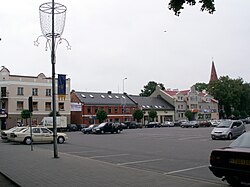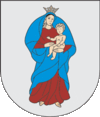Kretinga
| Kretinga | ||
|---|---|---|
| City | ||

Kretinga city square
|
||
|
||
| Location of Kretinga | ||
| Coordinates: 55°53′24″N 21°14′32″E / 55.89000°N 21.24222°ECoordinates: 55°53′24″N 21°14′32″E / 55.89000°N 21.24222°E | ||
| Country |
|
|
| Ethnographic region | Samogitia | |
| County |
|
|
| Municipality | Kretinga district municipality | |
| Eldership | Kretinga town eldership | |
| Capital of |
Kretinga district municipality Kretinga town eldership Kretinga rural eldership |
|
| First mentioned | 1253 | |
| Granted city rights | 1607 | |
| Population (2015) | ||
| • Total | 18,732 (18th) | |
| Time zone | EET (UTC+2) | |
| • Summer (DST) | EEST (UTC+3) | |
Kretinga (![]() pronunciation , German: Krottingen) is a city in Klaipėda County, Lithuania. It is the capital of the Kretinga district municipality. It is located 12 km (7.5 mi) east of the popular Baltic Sea resort town of Palanga, and about 25 km (16 mi) north of Lithuania's 3rd largest city and principal seaport, Klaipėda.
pronunciation , German: Krottingen) is a city in Klaipėda County, Lithuania. It is the capital of the Kretinga district municipality. It is located 12 km (7.5 mi) east of the popular Baltic Sea resort town of Palanga, and about 25 km (16 mi) north of Lithuania's 3rd largest city and principal seaport, Klaipėda.
The population was listed as 21,421 in the 2006 census. It is the 6th largest city in the ethnographic region of Samogitia and the 17th largest city in Lithuania.
Kretinga is one of the oldest known cities in Lithuania. It was first mentioned in 1253 as castle Cretyn under the charter of Bishop Heinrich of Courland.
In 1602 Jan Karol Chodkiewicz built the first wooden church in Kretinga and established a Benedictine monastery, which became a great success. After about ten years a new brick church with an impressive organ was built. In 1610 a church school was opened.
In 1609 Jan Karol Chodkiewicz announced that he would establish a new city next to the old village and would grant the new city Magdeburg rights. The new city adopted a coat of arms depicting the Blessed Virgin Mary with the baby Jesus in her arms. Kretinga's patron saint remains the Blessed Virgin.
...
Wikipedia


